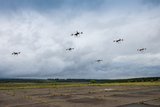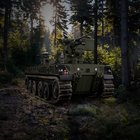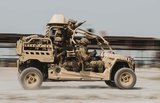CODE programme moves ahead
US DARPA's Collaborative Operations in Denied Environment (CODE) programme is moving ahead, awarding Phase 2 system integration contracts to Raytheon and Lockheed Martin, it announced on 3 June.
The CODE programmes aims to help US military UAVs to conduct long-distance, dynamic engagements of mobile maritime and ground targets in contested or denied electromagnetic airspace. It also aims to reduce the necessary communication bandwidth and the cognitive burden on supervisors.
Apart from awarding Phase 2 system integration contracts, DARPA has also selected six companies that had Phase 1 contracts to collaborate with the two prime contractors. The six companies are: Vencore Labs, SRI International, Soar Technology, Smart Information Flow Technologies, Scientific Systems Company and Daniel H. Wagner Associates.
If successfully implemented, UAVs equipped with CODE will be able to share data, negotiate assignments and synchronise communications and actions among team members and with a single human mission commander according to the agency.
The modular open software architecture of CODE will enable multiple CODE-equipped UAVs to navigate to their destinations and find, identify and track and engage targets. The UAVs could also add other friendly CODE-equipped UAVs to augment their capabilities.
The prototype human-system interface (HSI) of CODE is designed for a single person to visualise, supervise and command a UAV team. Mission commanders can track their team status and tactical situation, see pre-planned and alternative scenarios, and alter UAV activities in real-time.
The autonomy and HSI algorithms are being written in open architectures using the following standards: Unmanned Control Segment (UCS) and Future Airborne Capability Environment (FACE) of the army and navy, and Common Mission Command and Control (CMCC) and Open Mission Systems (OMS) of the air force.
Phase 2 will see DARPA implement a first subset of behaviours in each of two open architectures, and conduct live flight tests with one or two live UAVs and several virtual aircraft. DARPA may move to Phase 3 if the tests are successful.
In Phase 3, one team will test the capabilities using up to six live UAVs and more simulated vehicles. A single mission commander would be placed to perform a mission involving target identification, search and engagement.
Jean-Charles Ledé, program manager, DARPA, said: 'During Phase 1, we successfully demonstrated, in simulation, the potential value of collaborative autonomy among UAVs at the tactical edge, and worked with our performers to draft transition plans for possible future operational systems.
'Between the two teams, we have selected about 20 autonomous behaviours that would greatly increase the mission capabilities of our legacy UAVs and enable them to perform complex missions in denied or contested environments in which communications, navigation, and other critical elements of the targeting chain are compromised. We have also made excellent progress in the human-system interface and open-architecture framework.'
More from Uncrewed Vehicles
-
![Ready for the race: Air separation drone swarms vs. air defence systems]()
Ready for the race: Air separation drone swarms vs. air defence systems
As the dynamics of aerial combat rapidly evolve, Chinese scientists have engineered a sophisticated air separation drone model that can fragment into up to six drones, each capable of executing distinct battlefield roles and challenging the efficacy of current anti-drone defences such as the UK’s Dragonfire laser system.
-
![Israel’s MALE UAVs ‘must adapt’ to Iranian-made air defences]()
Israel’s MALE UAVs ‘must adapt’ to Iranian-made air defences
Advancements in air defence technologies have begun to reshape aerial combat dynamics in the Middle East, as illustrated by recent events involving the Israeli Air Force and Hezbollah.
-
![Hundreds more UAS sent to Ukraine forces with thousands more on the way]()
Hundreds more UAS sent to Ukraine forces with thousands more on the way
Both sides of the Russia-Ukraine war have been using UAS for effective low-cost attacks, as well as impactful web and social media footage. Thousands more have now been committed to Ukrainian forces.
-
![AI and software companies selected for US Army Robotic Combat Vehicle subsystems]()
AI and software companies selected for US Army Robotic Combat Vehicle subsystems
The US Army has intentions to develop light, medium and heavy variants of the Robotic Combat Vehicle (RCV) as part of the branche’s Next Generation Combat Vehicle family.
-
![DroneShield to improve software of DroneSentry-X C-UAS system under new contract]()
DroneShield to improve software of DroneSentry-X C-UAS system under new contract
DroneSentry-X, a cross-vehicle compatible, automated 360° C-UAS detect and defeat device, can offer 360° awareness and protection using integrated sensors. According to its manufacturer, it is suitable for mobile operations, on-site surveillance and on-the-move missions.
-
![Ukraine takes delivery of new indigenous C-UAS systems]()
Ukraine takes delivery of new indigenous C-UAS systems
Funded by the country’s former president, the new C-UAS systems will be sent to the frontline where they have already been tested against Russian invading forces.


























